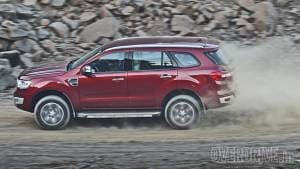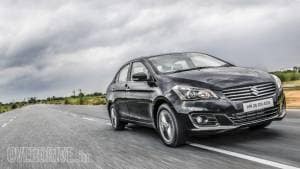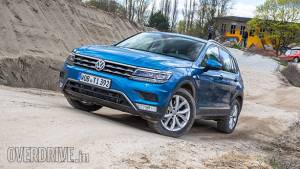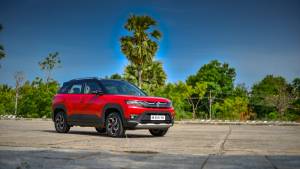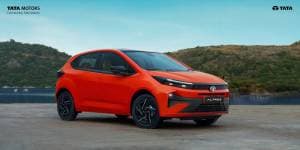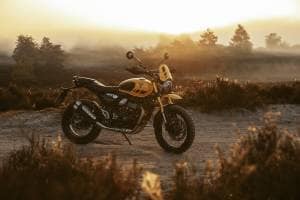What I learnt at my first track school weekend
As far as ticking the items off the bucket list go, a track day has always figured at the very top of mine. I've grown up watching some incredible riders flow from corner to corner on a motorcycle. I used to always picture myself doing that. I used to dream of what it would be like to ride in such an environment. Just me and my ride. I had read about Indimotard's TWO Track School even before joining OVERDRIVE. I've read the many, many words that Shumi's penned to urge people to experience it and become a better rider. Back then, neither did I have the money, nor the support to join. But last month, life gave me a chance and I grabbed it. I participated in Level One of the TWO Track School at the wonderful Kari Motor Speed Way in Coimbatore. What happened there has left an indelible impression on me and the way I ride.
Road to the track
I've been riding motorcycles for a little over a decade. The first motorcycle I rode was a Kawasaki Bajaj Caliber 115 . My maternal uncle taught me the fine art of releasing the clutch. I call it an art because it's such an achievement, as you can imagine, when you finally manage to set the bike rolling, without stalling or unintentional wheelies. I then got a Yamaha FZ which is currently the bike I own . I've had my fair share of rides on bigger machines too. All through these years, I've watched videos, other riders and practiced the tips that've featured in the Better Riding section of OVERDRIVE. I thought I knew to ride well, but the first classroom session blew away all notions that I'd summed up about riding a motorcycle. It was time to unlearn quite a lot of techniques and gather fresh but more importantly correct knowledge about motorcycles and how to ride them faster and safer.
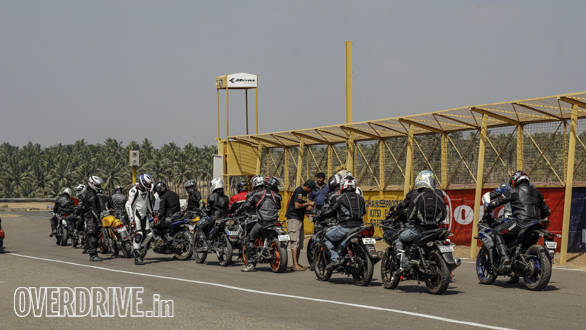
Basic training
The first session was all about learning how a motorcycle behaves and the extent of influence that the rider has over a two wheeled machine. The session on motorcycle geometry was detailed and critical to understand what a motorcycle does under acceleration and when on the brakes. I, to this date, never knew that when braking, the wheelbase of a motorcycle reduces, a teeny bit. Did you? This makes the bike unstable and consequently harder to control. If you're thinking of an example, watch how a MotoGP bike weaves and wallows under hard braking and how smooth it appears when on the throttle. It's this magical weapon that gives the fastest riders, those crucial tenths of a second. Throttle control is the ultimate means of riding a motorcycle quick and smooth, but I'll come to that a little later.
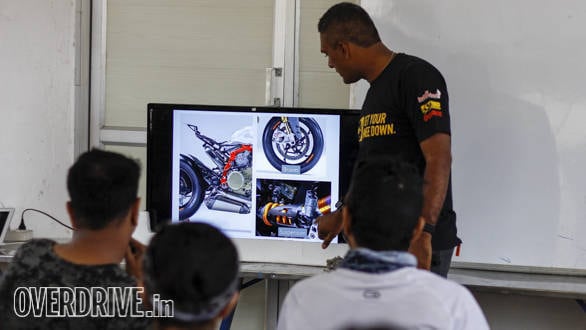
After the geometry and dynamics session , I was reminded of another problem area that I always faced - sitting right on a motorcycle. After joining OVERDRIVE, and while out on bike shoots, I've been pulled up by Shumi, Rishaad and Ashok on numerous occasions for sitting stiff. At the school, I learnt that correct body position is imperative to good motorcycle control (and reduced body fatigue). The right way is to hold the bike with the lower half of the body, while the upper portion stays loose and flows with the bike. We were told to keep the balls of our feet on the pegs, maintain a fist size distance between the tank and the crotch and hold the tank with your thighs. "So hard that after a long ride, the outsides of the thighs should hurt a little," said Shumi.
It was not easy and for the better part of the day I struggled to avoid sitting stiff. But as the hours increased, I slowly started to get a hang of it. It was easier to tip the bike into corners as well as change direction. The actual reason why I was so stiff, however, was diagnosed in the next session.

This session was more of a revelation, to me. It made we wonder how easy it is to ignore a seemingly innocuous but the most important tool to ride a motorcycle better- the human eye.
Our eyes have two types of visions, foveal and peripheral. While the former is good at gathering every detail of what lies straight ahead, the peripheral vision detects everything around that central point. It does not have the depth of detail as the foveal but is very good at detecting movement. For example, if you are riding on a busy highway, you'll be able to see the details of the make, model and even read the number plate of the vehicle in front of you. At the same time you are aware of the cars around this vehicle but you cannot read the number as clearly.
Together, the two types of vision feed the brain with tonnes of data which it uses to make decisions. The way you use this effective tool determines how fast you ride. On the track I noticed that when I had my head up and eyes pointing towards the exit of corners, I was carrying more speed that I thought. To my brain, it felt safe, and that had a lot to do with the what I was looking at.
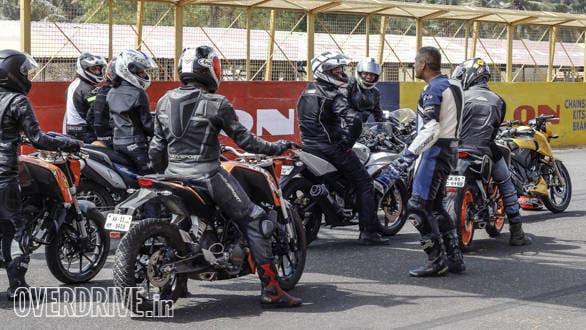
I tried another exercise, to train my brain. The technical complex of corners; C1, C2 and C3 at Kari are challenging, yet extremely rewarding when you nail it. And the eyes play a major role in the quest to sew those corners together precisely. In the beginning, I'd apex the first corner and continue looking at the exit until the point where I'd scare myself thinking I'll run out of road. I'd then turn my head towards C2 and get on the throttle again. All the while I'd be off the throttle and coasting, thus unsettling the bike and losing a lot of time. The instructors then taught us the importance of using the eye. "Let your eyes lead the ride and not the ride lead your eyes." they said.
I'd now apex C1, look at the turn in point and then turn my head, 90 degrees and look at the exit of C3, and the motorcycle would always pass the same spot.
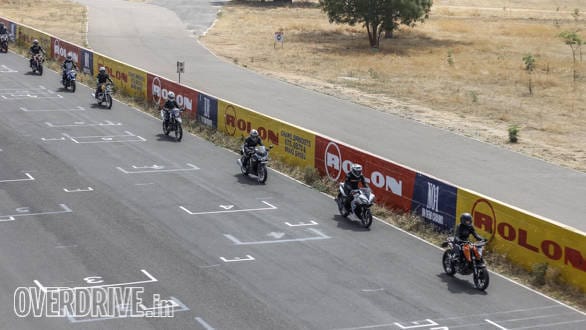
Lap after lap, I began to understand and use my eyes to my advantage. Corner speeds kept increasing with time and slowly, and surely the fear began ebbing away. My brain was not kicking in and alarming me but instead began to accept that what I was doing is all right. My eyes kept telling my brain that there is so much room/road available after the C1 apex which in turn helped me get on the throttle early.
That is another aspect that aided the transformation. The instructors throughout the sessions kept drilling a simple fact into our head, that the throttle is a friend. Keeping the motorcycle on the throttle for as long as possible, around the track, meant serious increments in pace arising out of a greater sense of safety. With the eyes now seeing a lot more road, I was able to roll on the throttle early and exit faster on to the straights. The motorcycle too felt settled as they said. This was apparent in the section of corners called, The Bermuda. Named after the Bermuda Triangle, and because many riders have been caught off guard at this chicane, the Bermuda is a great challenge. The chicane begins with a slight downhill left and then immediately turning right onto itself and exiting into a right hand curve. The trick to get this right was to tip the bike to the left hander, stay gently on the throttle, look away into the right hander at the exit and roll on the gas smoothly. I used to get it wrong quite often, but as the old adage goes, practice makes a man perfect. By the end the last session I got it right, and needless to say, it felt like a mega achievement.
While we are at corners, the drill on counter steering taught me why this skill is so important for corner entry. We were asked to ride to about 30kmph whilst keeping the left hand on the chest. After reaching the desired speed, we had to push the right side end of the handlebar gently, and notice how the motorcycle tipped to the right, almost effortlessly. On the track , I began understanding the beauty of countersteering and its effectiveness in scraping off lap times. The motorcycle would almost telepathically turn in the direction where the handlebar is pushed, thereby reducing effort as well as saving time on turn in.
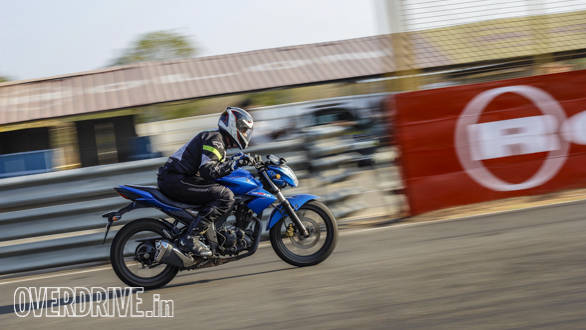
Another fear that I overcame at the track is only using the front brake with confidence. Inertia tilts the motorcycle forward during braking, or even when you roll off the throttle. This effect is called weight transfer, which renders the front wheel with the most traction/grip (that's why big bikes have twin discs up front, and even a single disc up front has a larger diameter than the unit on the rear wheel). Applying the front brake progressively helped me understand brake modulation as well as learn far more feel from the front tyre. In simpler words, I was able to understand how much available traction there is before the front washes out. I was scared initially, but began braking later as confidence grew. No, I'm not 100 per cent confident in using the front brakes, but I'm slowly getting there.
What I've learnt at the track has been firmly etched in my memory. But I need practice. All those lessons, have made me confident, faster and a safer rider on the road. I'm aware of how effective my eyes are and how they influence my right wrist. I've learnt that riding a motorcycle needs unwavering focus. It's also physically demanding. I've grown a paunch over the last couple of years and the effects manifested on the track. I've realised that maintaining good physical health equals to better, more involving saddle time.
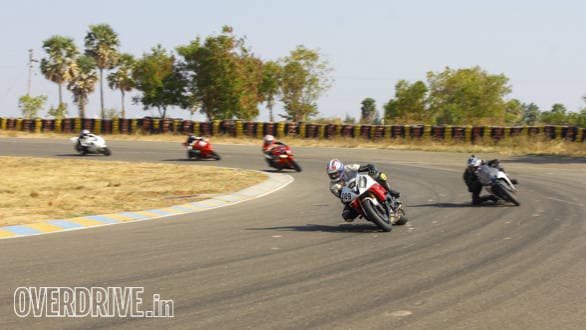
I also regret not attending the school all along, and more importantly not riding on a racetrack before this. It's life altering in every sense of the word. A racetrack is the ultimate place to understand the nuances of riding a motorcycle. It is traffic free, its characteristics don't change which creates a familiar environment to learn in. On a motorcycle, the experience is surreal. Nothing can supersede the feeling you get when you manage to perfect the line around a corner. In fact, I kept recollecting memories from the track day, even when I lie on my bed in Mumbai weeks later. I'm hooked!
It's a feeling of accomplishment that you get when you know you've worked hard towards achieving. Riding on the race track has made me fall in love with riding, to a deeper extent than ever before. I've begun to understand, in detail, the beauty of motorcycles. Why they generate such true and intense emotions. Why it's such an incredibly rewarding addiction. I wish I had done this before, but I know for sure, I'm going to enjoy riding till I possibly can.
If you have an iota of hunger to ride better. If you love motorcycles and the way they make you feel. If you want to experience the sensations that a ride on a racetrack generates, and if you don't want to regret missing the bus like me, get on and sign up for the next session. It'll be the best decision you've taken, you have my word. As far as I'm concerned, I've queued up for Level Two. As far as you are concerned, well, what are you waiting for? Sign up!
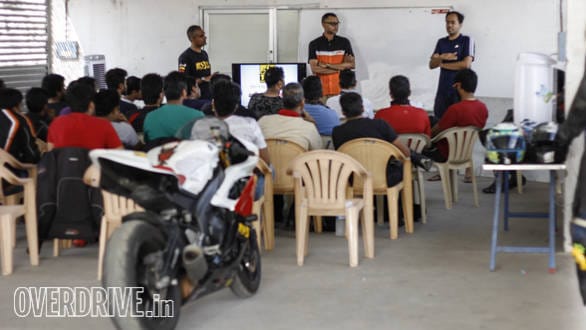
The instructors at Indimotard's TWO Track School...
... are super eager to see you learn. I felt comfortable in asking questions and they were more than happy to teach. Anand, Shumi, Vignessh and Dodo are avid motorcyclists with years of riding experience under their respective belts.
But what's infectious is their love for motorcycles. You can see their eyes light up when words like speed, corners, chassis, suspension, motorcycle, etc. are spoken. It makes you feel home. It makes you feel like you're in the right place.
Besides the theory lessons, where every detail is covered, they follow you around the track as you put to practice what's taught in class. If you're scared they know. They'll ride with you and correct you after pulling over at a safe spot. They'll stick with you till you get it right; they are never out of patience. I feel that's because they love what they do.
They have this treasure chest of riding knowledge that they're willing to share/impart in whoever wants to learn. I guess that's courtesy of unbridled passion that inflames their hearts. I was lucky to have spent a weekend with some of the best riding instructors in the country. They made learning enjoyable.
